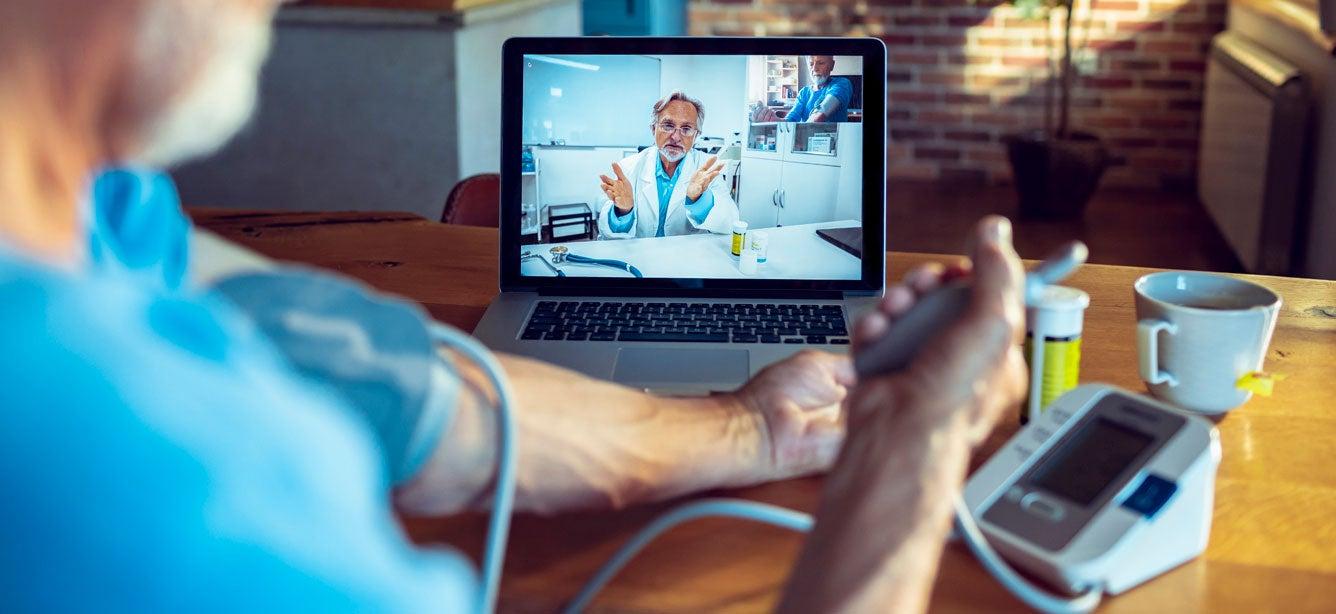
Related Topics
Before the pandemic, Original Medicare Part B covered telehealth in limited situations. Medicare has since expanded coverage and access to telehealth to ensure older adults have access to health care services. These flexibilities have allowed more people with Medicare to use telehealth and may be helpful for meeting your health care needs.
What is telehealth?
Telehealth includes certain services that you receive from a health care provider outside of an in-person office visit. A telehealth service is a full visit with a provider using telephone or video technology that allows for both audio and video communication.
Does Medicare cover telehealth?
Original Medicare covers telehealth services under Part B. Some examples of Medicare-covered telehealth benefits include:
- Lab test or x-ray result consultations
- Post-surgical follow-up
- Prescription management
- Preventive health screenings
- Urgent care issues like colds, coughs, and stomach aches
- Mental health treatment, including online therapy and counseling
- Treatment of recurring conditions, like migraines or urinary tract infections
- Treatment of skin conditions
What does telehealth cost under Medicare?
After you meet the Medicare Part B deductible ($257 in 2025), you will pay 20% of the Medicare-approved amount for the service from providers who accept Medicare assignment. If you are enrolled in a Medicare Advantage Plan, contact your plan to learn about their telehealth costs.
Cost-sharing for telehealth has not changed during COVID. However, your provider may choose to reduce or waive cost-sharing for telehealth visits. Providers usually cannot routinely waive cost-sharing, but this flexibility is available during the pandemic.
How did Medicare covering telehealth during the pandemic?
Services
Original Medicare expanded the list of covered telehealth services during the pandemic, including emergency department visits, physical and occupational therapy, and certain other services. For example, a doctor can use telehealth in place of the face-to-face visits required to prescribe Medicare-covered home health care. Ask your doctor about telehealth options and whether it would be suitable for your health care needs.
Locations
Previously, only Medicare beneficiaries in rural areas could access telehealth, and they were required to travel to an authorized health care setting such as a physician’s office or hospital. During the pandemic and until April 1, 2025, telehealth services are covered for all beneficiaries in any geographic area, and you can receive these services at home in addition to health care settings.
Technology requirements
You must generally use an interactive audio and video system that allows for real-time communication with the provider. Providers are temporarily allowed to use any non-public facing remote technology (such as FaceTime, Zoom, or Skype) to communicate with their patients.
During the pandemic, limited telehealth services could be delivered using audio only, via audio-only telephone or a smartphone without video. These services included counseling and therapy provided by an opioid treatment program, behavioral health care services, and patient evaluation and management.
Providers
Previously, Medicare only covered telehealth services provided by eligible practitioners, such as physicians and nurse practitioners. During the pandemic, any health care professional eligible to bill Medicare for professional services could provide and bill for telehealth services. This included physical therapists, occupational therapists, and speech language pathologists.
Medicare Advantage
Medicare Advantage Plans must cover all of the telehealth benefits included in Original Medicare. In response to COVID, Medicare Advantage Plans also have the flexibility to expand coverage and reduce or waive cost-sharing for telehealth services.
Did the expanded coverage of telehealth end after COVID?
Through March 31, 2025, you can get telehealth services at any location in the U.S., including your home. Starting April 1, 2025, you must be in an office or medical facility located in a rural area (in the U.S.) for most telehealth services. If you aren't in a rural health care setting, you can still get certain Medicare telehealth services on or after April 1, including:
-
Monthly End-Stage Renal Disease (ESRD) visits for home dialysis
-
Services for diagnosis, evaluation, or treatment of symptoms of an acute stroke wherever you are, including in a mobile stroke unit
-
Services for the diagnosis, evaluation, or treatment of a mental and/or behavioral health disorder (including a substance use disorder) in your home
Should I be wary of potential fraud related to telehealth?
Yes. With the expansion of telehealth services, you should be aware of people using telehealth for fraudulent purposes. The following scenarios are examples of potential telehealth fraud:
| Scenario | Potential Fraud |
|---|---|
| You are contacted by a provider you do not know or have not met before to set up a telehealth appointment. The caller offers cash payments or free prescription drugs to get your personal information. | The caller will likely start billing Medicare for items and services you do not need or do not receive, like lab tests, braces, or orthotics. |
| You receive an unsolicited phone call from someone wanting to verify your pain symptoms. | The caller is likely a telehealth doctor trying to approve you for durable medical equipment (DME) that you do not need or did not request. |
| You receive an unsolicited phone call from someone wanting to verify your family history of cancer. | The caller is likely a telehealth doctor trying to approve you for a genetic testing kit that actually needs to be ordered by your treating physician. |
If you suspect fraud, you should call 1-800-MEDICARE. You can report potential telehealth fraud, errors, or abuse to your local Senior Medicare Patrol.



